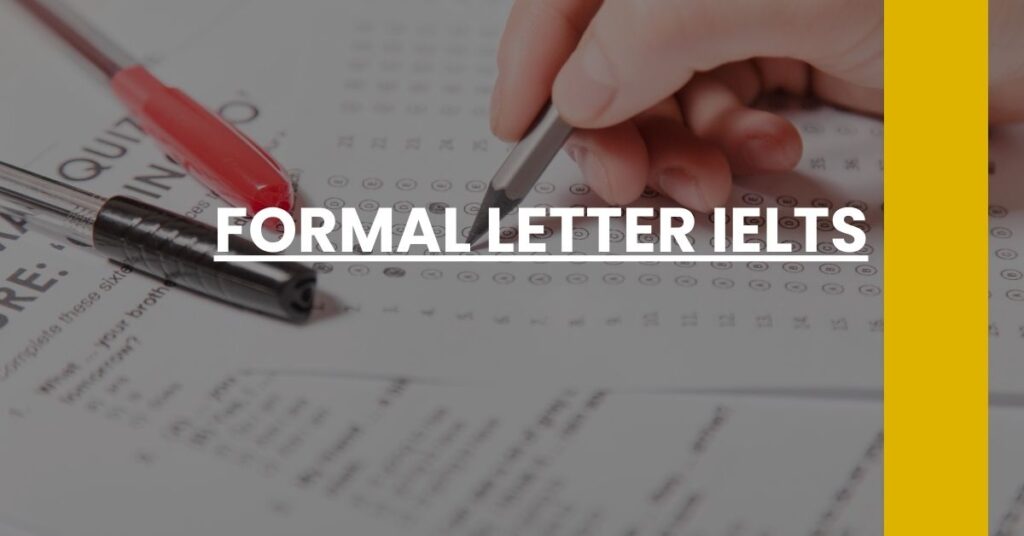Formal letter IELTS mastery is crucial for acing the writing task with confidence.
- Essential Components: Master the vital elements of formal letter IELTS structure.
- Effective Tone: Command the professional tone needed for a high-scoring formal letter.
- Core Vocabulary: Utilize key phrases to enrich your IELTS formal letter.
Crafting a formal letter for IELTS just got easier.
- Understanding the IELTS Formal Letter Task
- The Purpose of Writing Formal Letters in IELTS
- Identifying a Formal Letter’s Tone and Style
- Key Components of a Formal IELTS Letter
- Structuring Your Letter Effectively
- Essential Vocabulary and Phrases for Formal Letters
- Common Pitfalls to Avoid in IELTS Letter Writing
- Practice Strategies for IELTS Formal Letters
- Sample Formal Letters and Examiner’s Feedback
- Conclusion: Key Takeaways for IELTS Success
Understanding the IELTS Formal Letter Task
When you sit down to tackle the IELTS General Training Writing Test, expect to flex your letter-writing muscles. This part of your IELTS journey pits you against a challenge where you’ll craft a letter in a tone that’s just right for the occasion – often, this means writing a formal letter. Let’s delve into the craft of formal letter writing, a skill that proves essential not only for acing the IELTS but also for communicating effectively in the professional world.
What Exactly Is a Formal Letter in the IELTS Context?
A formal letter, within the IELTS exam, is a piece where you respond to a given situation that calls for a structured and respectful tone. Perhaps you need to explain a missed appointment or request information from a government agency. Regardless of the scenario, your goal is to convey your message with clarity and courtesy.
Why Does It Matter?
Your letter is a mirror reflecting your ability to navigate formal interactions in English. It showcases your command of the language and your understanding of proper etiquette. For this task, scoring high hinges on your power to blend formality with fluidity.
The Purpose of Writing Formal Letters in IELTS
At its core, the formal letter task assesses your proficiency in professional communication. It’s essential to pin down the purpose of your letter – are you complaining, requesting information, or making arrangements? Grasping this from the get-go guides the tone and content of your correspondence, ensuring each sentence paves the path toward your goal.
Types of Formal Letters
- Job Application: Crafting an application letter that sparkles with professionalism can open doors.
- Complaint: Sometimes, you need to raise concerns respectfully – and your words must carry the weight of your dissatisfaction without tipping into discourtesy.
- Request: Information is often just a well-worded letter away. Ensure you phrase your queries with precision and politeness.
Identifying a Formal Letter’s Tone and Style
The right tone is like the perfect attire for an interview; it must be fitting and appropriate. In formal letters, this translates to using a respectful and serious tone throughout. No slang, no colloquialisms. Just sheer, refined language that speaks volumes of your ability to partake in professional discourse.
Tailoring Your Language
- Salutations: A proper “Dear Sir/Madam” sets the stage.
- Vocabulary: Opt for words that exude formality – ‘assist’ vs. ‘help’, ‘purchase’ vs. ‘buy’.
- Closing: Your sign-off matters. “Yours faithfully,” or “Yours sincerely,” can be just the graceful exit to leave a positive lasting impression.
Key Components of a Formal IELTS Letter
Peel back the layers of an outstanding formal letter, and you’ll find a structure that’s as rigid and reliable as etiquette at a royal tea party. Each part of your letter is a cog in the machine of communication, each needing to perform its role flawlessly.
The Framework of Formality
Your letter is more than just words; it’s a puzzle where every piece must fit perfectly. Here’s what you should include:
- Sender’s Address: Situate yourself in the world. Begin with your address, tucked away at the top right corner.
- Date: Just below your address, the date stamps a moment in time.
- Receiver’s Address: You’re reaching out to someone; ensure their address is correctly stated.
- Salutation: “Dear” followed by their title and surname or a simple “Sir/Madam” if the name is unknown.
- Body: A trio of paragraphs that introduce, detail, and conclude your purpose.
- Closing: Bid farewell with “Yours faithfully,” followed by your signature and printed name.
Structuring Your Letter Effectively
An impactful formal letter is like a well-rehearsed speech – it flows, persuades, and retains the audience’s (or in this case, the reader’s) attention from the beginning to the end. Here’s how to ensure your letter reads like a symphony rather than a cacophony.
Organizing Your Thoughts
- Introductory Paragraph: This is where you set the scene, greeting the reader and stating the letter’s purpose.
- Main Body: Divide the main content into paragraphs, each tackling a separate aspect of your letter’s purpose.
- Concluding Paragraph: End with a respectful sign-off, reiterating your reason for reaching out and prompting a response or action.
Polishing Transitions
Don’t just jump from one idea to the next; sew your thoughts together with transitions that carry the reader along a smooth journey from introduction to finale. Words like “furthermore,” “moreover,” and “consequently” can guide readers through your narrative with ease.
And remember, as you draft your formal letter for the IELTS exam, keep your reader squarely in mind. Write not just to express but to connect, to respect, and to get results. Your ability to wield words with finesse in this format will undoubtedly cast a favorable light on your English language skills.
Essential Vocabulary and Phrases for Formal Letters
Crafting the perfect formal letter IELTS submission means carefully selecting the right words and phrases to convey your message with respect and precision. Aim to enhance your formal letter with vocabulary and phrases that demonstrate your command of English in a business or official context.
Language that Sets the Formal Tone
Your choice of language can be the deciding factor between an average and an outstanding letter. Let’s equip you with:
- Introductions: Start with phrases like “I am writing to…” or “I wish to bring to your attention…”
- Requests: Use “I would be grateful if you could…” or “I seek your assistance in…” to ask politely.
- Referring to Previous Communication: If needed, use phrases like “Following our recent conversation…” or “As per our agreement…”
- Closing Remarks: Seal your letter with “Thank you for your consideration.” or “I look forward to your prompt response.”
By interweaving these phrases appropriately, you ensure your letter resonates with the decorum expected in a formal context.
Building Out Your Vocabulary Bank
It is pivotal to fortify your vocabulary for various scenarios you might encounter in the IELTS task:
- For Making Enquiries: Words and phrases like “I am writing to inquire about…” or “Could you please provide…” are useful.
- For Complaints: “I regret to inform you that…” or “I must express my dissatisfaction with…” convey your displeasure respectfully.
- For Applications: Employ phrases such as “I am writing to apply for the position of…” to indicate your intentions.
Incorporating a rich palette of vocabulary and phrases is a skillful way to tailor your formal letter to the IELTS evaluator’s expectations.
Common Pitfalls to Avoid in IELTS Letter Writing
Even the most cautious writers can occasionally veer off the formal path. To strengthen your formal letter IELTS endeavors, beware of these commonplace traps:
Avoiding Casual Language
Always remember that phrases suitable for a chat with friends are out of place in a formal letter. Steer clear of:
- Slang and idioms – They tend to diminish the letter’s formality.
- Contractions – Write “do not” instead of “don’t”, “will not” instead of “won’t”, etc.
Maintaining the Right Formality Level
Sometimes, it’s a thin line between being overly familiar and coldly impersonal. It’s essential to:
- Use titles and last names unless instructed otherwise.
- Keep a balanced tone that is courteous but not overly friendly.
These tips keep your writing on track, portraying you as a genuine professional equipped for real-world engagements.
Practice Strategies for IELTS Formal Letters
Practice not only makes perfect, it’s also a bridge to enhanced confidence. Here are some strategies to refine your formal letter IELTS writing skills:
- Frequent Writing Practice: Consistently write letters hinged on varied scenarios to build agility.
- Peer Reviews: Exchange letters with peers and welcome constructive criticism.
- Timed Sessions: Mimic exam conditions by timing your writing process to build efficiency.
Routine practice anchors your knowledge and refines your letter-writing savoir-faire, making you a formidable candidate for the IELTS Writing Task 1.
Sample Formal Letters and Examiner’s Feedback
Analyzing sample letters is a telescope into the expectations of the IELTS. By reviewing successful samples, you gain insights into:
- Effective Structuring: Witness firsthand how coherence and cohesion bring an argument full circle.
- Judicious Vocabulary Use: Observe how the strategic use of formal vocabulary lifts the quality of the writing.
- Adherence to Task Requirements: Understanding the task can be half the battle, and these samples elucidate this crucial step.
For optimal learning, compare these analyses with feedback from examiners, noting areas earmarked for improvement and how to apply such lessons to your writing.
Conclusion: Key Takeaways for IELTS Success
As we wrap up, carry with you the assurance that mastering the formal letter IELTS writing task is within your reach. With the right tools, techniques, and tenacity, your letter will not only be a response to a prompt but a testament to your eloquence in English communication. Hold onto the essential ingredients – structure, tone, vocabulary, and practice – and the recipe for IELTS success is yours. Make each word count, each sentence flow, and every paragraph a stepping stone to achieving your target band score.
Master the formal letter IELTS task with expert strategies and tips to ace your writing exam. Ensure top scores today!

